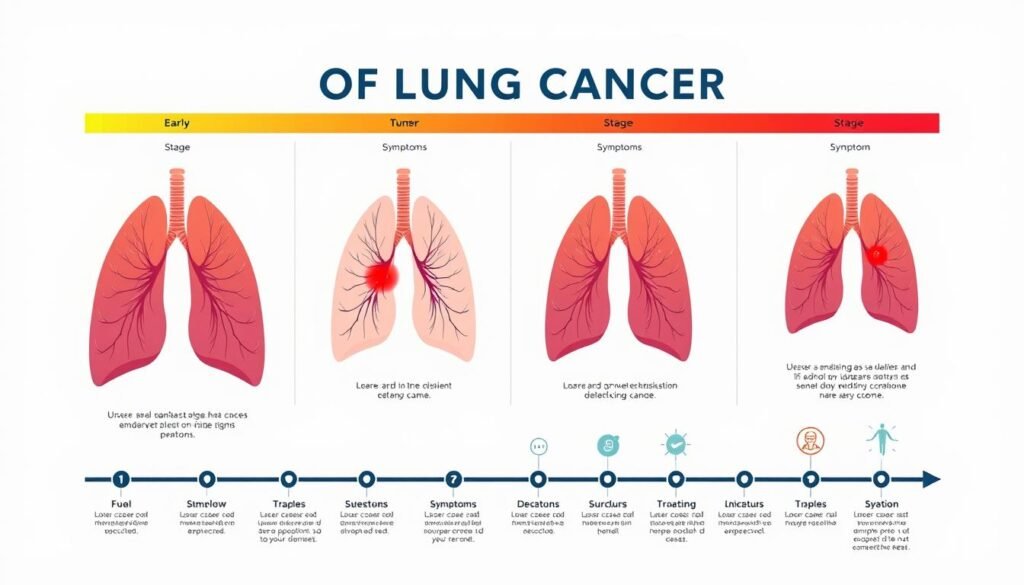Did you know about 65% of people with stage 1 lung cancer live five years or more? This important fact shows that positive outcomes are possible. It also points to the need to grasp lung cancer life expectancy’s complex nature. Understanding the intricacies of this illness is crucial as it varies greatly among patients. This variation is due to several elements including the cancer stage, treatment options, and overall health.
This guide is designed to shed light on lung cancer survival rates, crucial prognostic factors, and available treatments. It stresses the importance of having one-on-one talks with medical experts. For those facing early-stage lung cancer, knowledge of support systems and what the journey entails brings solace.
Key Takeaways
- Stage 1 lung cancer has the highest survival rate, with almost 65% surviving for five years or more.
- Factors influencing lung cancer prognosis include cancer stage, type, and overall health.
- Discussions with healthcare professionals are vital for understanding individual outcomes.
- Understanding various treatment options can significantly affect lung cancer survivability.
- Awareness of emotional and psychological impacts is crucial during the treatment journey.
Understanding Lung Cancer Survival Rates
Lung cancer survival rates give us important information. They help us understand how long patients live after diagnosis. Less than 20% of those diagnosed with lung cancer live for five years or more. This makes it one of the deadliest cancers, only second to pancreatic cancer.
When lung cancer is found early, the chances of survival are better. But sadly, about 40% of lung cancers are found very late. Younger people have a bit higher survival rates than older ones.
Knowing survival rates for each stage brings hope and some clear facts. For example, non-small-cell lung cancer (NSCLC) has better odds when found early, with a 60% survival rate. But if it has spread far, the rate drops to just 6%. Small-cell lung cancer (SCLC) shows even lower rates, with only 29% surviving early-stage cancer and 3% for advanced stages. These numbers show why finding cancer early and starting treatment right away is crucial.
Click here for current lung cancer statistics. They show big differences in survival based on the patient’s age and the cancer type.
New treatments are making a difference in lung cancer outcomes. More people are living longer, even though lung cancer still causes the most cancer deaths. The fall in lung cancer deaths over recent years is a positive sign. Understanding these survival rates helps patients and their families have realistic hopes. It also shows why we must keep supporting lung cancer research.
| Stage | NSCLC 5-Year Survival Rate | SCLC 5-Year Survival Rate |
|---|---|---|
| Localized | 60% | 29% |
| Regional | 33% | 15% |
| Distant | 6% | 3% |
| All Stages | 23% | 6% |
Prognostic Factors Affecting Life Expectancy
Prognostic factors greatly impact life expectancy for those with lung cancer. It’s critical to understand these to tailor the right treatment. Early diagnosis means better odds of survival. For example, early stages of non-small cell lung cancer (NSCLC) offer more hope than later stages.
Age and health also play big roles in prognosis. Older patients may not react well to chemotherapy and face more health issues like anemia. Studies show a clear divide in survival times between older and younger individuals. This shows why considering each patient’s unique health status is vital.
The table below outlines key factors and how they affect lung cancer survival:
| Prognostic Factor | Impact |
|---|---|
| Stage of Lung Cancer | Earlier stages (0, 1) lead to better outcomes; advanced stages (2, 3, 4) have lower survival rates. |
| Patient Age | Elderly patients show poorer outcomes compared to younger counterparts. |
| Type of Lung Cancer | NSCLC typically has a better prognosis than small cell lung cancer. |
| Weight Loss | Loss of >5% body weight before treatment correlates with a worse prognosis. |
| Performance Status | Higher performance scores indicate better treatment tolerance and outcomes. |
| Gender | Women often have a slightly better prognosis compared to men with the same diagnosis. |
| Coexisting Health Issues | Lung and heart problems combined worsen prognosis significantly. |
https://www.youtube.com/watch?v=ihCnDjyJv5c
How Long To Live With Lung Cancer
Lung cancer survival rates depend on many factors, including the stage at diagnosis. Finding the cancer early can lead to better treatment outcomes. People with stage 1 lung cancer usually have a higher chance of living longer than those with advanced cancer.
Survival Rates by Lung Cancer Stage
The stage of lung cancer affects how long patients might live. For stage 1 non-small cell lung cancer (NSCLC), five-year survival rates are between 70% and 92%. This percentage depends on the cancer’s specific features. For stage 4 patients, the chance of living five years after diagnosis drops to 5%. Below are more detailed survival rates:
| Stage | Survival Rate |
|---|---|
| Stage 1a1 | 92% |
| Stage 1a2 | 83% |
| Stage 1a3 | 77% |
| Stage 1b | 68% |
| Stage 2 | 40% |
| Stage 4 | 5% |
Impact of Age on Survival Rates
Age is key in figuring out lung cancer survival. Younger patients usually have better outcomes. Specifically, people under 50 with stage 1 lung cancer have a survival rate of 83.7%. But, the rate falls to 54.6% for those over 65. These stats help tailor treatment plans and set expectations.
Being proactive can improve survival chances. Taking part in clinical trials and managing health can make a big difference. Spotting symptoms early is crucial for successful treatment, which can lead to living longer.
Lung Cancer Staging Explained
Lung cancer staging is crucial in setting the plan for a patient’s care. It weighs things like the tumor’s size and spot, if lymph nodes are involved, and if it has spread. Knowing about lung cancer stages helps patients choose their treatment wisely.
Stage 1 Lung Cancer Survival Statistics
In stage 1, the cancer hasn’t spread outside the lungs. About 65% of people live at least five years after being diagnosed at this stage. Early treatment, often surgery, can greatly improve a person’s chance to survive.
Stage 2 Lung Cancer Survival Statistics
Stage 2 lung cancer is more serious and often reaches lymph nodes near the lung. The five-year survival rate falls to about 40% here. Despite the decrease, personalized treatments like surgery, chemo, and radiation are available. Patients are encouraged to understand stage 2 cancer well to make informed treatment choices.

Treatment Options for Lung Cancer
Lung cancer treatment involves various strategies considering disease stage, tumor type, and patient health. It combines different therapies for best results. These include surgery, radiation, targeted therapy, and chemotherapy, especially for early-stage cases.
Surgical Intervention for Lung Cancer
Early-stage lung cancer often requires surgery. This involves removing part of the lung or the entire organ plus affected lymph nodes. The aim is to remove the cancer early, mainly in stages 1 and 2, where it hasn’t spread far.
Radiation Therapy for Lung Cancer
Radiation therapy can be used before or after surgery for lung cancer. It’s effective for cancer spread within the chest. Techniques like stereotactic body radiotherapy precisely target tumors, protecting healthy tissue. It’s a key choice for small or spread cancers.
Targeted Therapy for Lung Cancer
Targeted therapy has transformed lung cancer treatments, focusing on cancer growth molecules. It’s suitable for advanced or recurrent stages. Tailoring treatments based on genetic mutations, like EGFR or ALK, enhances their effectiveness against cancer.
Chemotherapy for Early-Stage Lung Cancer
Chemotherapy aims to kill remaining cancer cells post-surgery in early stages. It can also shrink tumors before surgery. Chemoradiation, a mix of chemotherapy and radiation, often improves results in advanced stages.
Early-Stage Lung Cancer Therapy
Early-stage lung cancer treatment usually combines surgery and chemotherapy. Oncologists may suggest varying methods based on cancer characteristics to improve outcomes. The therapy landscape for lung cancer is constantly advancing, offering new management options.
| Treatment Type | Indications | Typical Approach |
|---|---|---|
| Surgical Intervention | Early-stage lung cancer | Removal of tumor and possibly part of the lung |
| Radiation Therapy | Post-surgery or for localized cancers | Focused radiation targeting tumor sites |
| Targeted Therapy | Advanced stages with specific gene mutations | Drugs that block cancer cell growth factors |
| Chemotherapy | Post-surgical or before surgery to shrink tumors | Systemic treatment to kill cancer cells |
Factors Influencing Treatment Outcomes
Understanding what affects treatment outcomes is key in lung cancer care. The type of lung cancer is a major factor. There are two main types—non-small cell lung cancer (NSCLC) and small cell lung cancer (SCLC). Each has different survival rates.
Type of Lung Cancer and Its Impact on Survival
Non-small cell lung cancer usually has better outcomes than small cell. For example, early-stage NSCLC patients often do well with surgery, leading to higher survival rates. On the other hand, SCLC has a 25% five-year survival for limited disease. But, for extensive disease, the rate can drop to 1% to 5%. This shows why treatments must be tailored to the cancer type.
General Health and Fitness
A patient’s health and fitness greatly affect treatment results. Things like smoking history, other illnesses, and lifestyle choices impact recovery. Studies show that people who quit smoking survive longer than those who smoke. Also, taking vitamins and minerals can help people with both NSCLC and SCLC live longer. So, health and fitness are crucial for treatment success and survival.
The Role of Clinical Trials in Lung Cancer Treatment
Lung cancer clinical trials are key to finding better treatments and improving lives. Patients in these studies get to try new treatments that most people can’t yet access. Through lung cancer research, we’re finding new ways that might change how we treat this disease.
Durvalumab (Imfinzi) is one success story. It’s been FDA-approved for certain lung cancer patients. After finishing usual treatment, those on durvalumab had a higher three-year survival rate. This shows how new treatments from trials can really help.
During the ADRIATIC trial, durvalumab also increased overall survival. Patients went from 33 months with a placebo to 56 months. This means they lived longer without their cancer coming back. This shows how important clinical trials can be for lung cancer patients.
But, clinical trials have risks too. Some patients in the ADRIATIC trial had serious side effects. Even so, these trials bring new hope to lung cancer patients. They offer the chance for a better future.
Emotional and Psychological Impact of a Lung Cancer Diagnosis
Getting diagnosed with lung cancer brings strong emotions. People often feel scared, anxious, and sad. This affects not just the patient, but their family and friends too. It’s important to understand these feelings to truly get what patients go through during treatment.
Many people with lung cancer face tough emotional struggles. Studies show that about 60% of them deal with mental health issues. Feelings of depression, anxiety, and stress are common. Yet, only 10% get help from mental health professionals. This shows a gap in supporting patients’ psychological needs.

How patients cope with lung cancer can really change their lives. Things like exercise, keeping a positive spirit, and easing symptoms help improve their mood. There’s proof that feeling better mentally can help patients live longer and suffer less.
- Support from mental health professionals is crucial.
- Counseling services can provide coping mechanisms tailored for patients.
- Peer support groups foster community and shared experiences.
| Psychological Distress Type | Mean Score (± SD) |
|---|---|
| Depression | 4.55 ± 5.04 |
| Anxiety | 3.84 ± 4.17 |
| Stress | 5.21 ± 5.01 |
It’s vital for healthcare workers to talk about mental health openly. Doing this helps lower stigma and makes support more accessible. When emotional issues are tackled early, patients can have better health results and enjoy life more.
Getting Support During Treatment
During lung cancer treatment, support is key for a patient’s well-being. Family and friends, along with professional help, form a vital support system. They help lessen the emotional and physical stress faced by patients.
Many find comfort in patient support groups. These groups let people share their stories and gain encouragement. They provide tips for dealing with treatment and the disease itself.
Using resources for lung cancer patients also aids in their treatment journey. Orgs focused on lung cancer give personalized help, ensuring no one feels alone. These resources can help improve a patient’s mood, especially if they feel anxious or sad after their diagnosis.
Being part of a community provides chances to talk about treatment and life post-recovery. It’s crucial to communicate well with doctors. This helps patients understand their diagnosis and treatment options better.
The emotional path can be tough. Getting help early on can make coping easier.
Knowing there’s a lot of support out there can give patients and their families hope. Whether it’s through organized support groups or casual meet-ups with close ones, this support is uplifting. It gives them strength and courage when they need it most.
Living with Lung Cancer: Patient Stories and Insights
Lung cancer patient stories show us the varied lives of those diagnosed. Each story has its own lessons on resilience and hope. Linnea Olson, for example, was diagnosed at 45. She’s been navigating her lung cancer journey for over 15 years now. Participating in clinical trials, she has seen the potential of treatments that can prolong life.
Barbara Adelman’s story gives us a different, enlightening view. She was diagnosed with stage I lung cancer and chose surgery without chemo or radiation. Now, she’s in remission. Despite the fear and depression, she stays active. She exercises daily and rides horses. This helps her physically and mentally. These survivor insights inspire those new to the lung cancer community.

Connection is key when living with lung cancer. Olson found comfort in an online group. Adelman joined a LUNG FORCE panel, connecting with people who get her struggle. Support systems prove invaluable, as seen in Lisa Hamburger’s story. She cut down work hours to take care of her husband, showing the need for an advocate.
Many stories highlight the strength found in community. From Bruce, raising lung cancer awareness in the military, to Gerri, living fully with stage 4, these narratives are varied.
Recognizing symptoms early is crucial for better outcomes. Awareness can lead to early detection, which can greatly improve survival rates.
As treatments for lung cancer improve, patient stories bond those affected. They foster determination and share a common goal. Despite the hurdles, these individuals’ stories celebrate the human spirit. They stand united against lung cancer.
| Name | Diagnosis Year | Current Status | Support System |
|---|---|---|---|
| Linnea Olson | 2005 | Living with cancer for over 15 years | Best friend (advocate) |
| Barbara Adelman | 2014 | In remission | Limited support |
| Lisa Hamburger | N/A | Caregiver | Reduced work hours for support |
| Gerri | N/A | Living with stage 4 | Support group involvement |
Conclusion
Living with lung cancer is a complex journey. It’s shaped by personal situations, treatment choices, and new medical advances. Different patients face different outcomes. Factors like the cancer’s stage, patient’s age, and overall health matter a lot. Recently, survival rates have improved, reaching 28.4% for five years.
Knowing survival rates helps patients and families get ready for what’s ahead. Though lung cancer is scary, understanding treatment options is empowering. Treatments range from surgery to targeted therapies. Early screening is crucial, as it can greatly lower death rates.
The experience of having lung cancer is different for everyone. Getting support from doctors or community resources is key. Patients should focus on what makes their journey unique. They should learn about treatments and manage their health. With the right support and information, their life’s quality can improve.